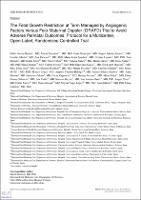| dc.contributor | Consorci Sanitari de Terrassa |
| dc.contributor.author | Garcia-Manau, Pablo |
| dc.contributor.author | Bonacina, Erika |
| dc.contributor.author | Martin-Alonso, Raquel |
| dc.contributor.author | Martin, Lourdes |
| dc.contributor.author | Palacios, Ana |
| dc.contributor.author | GARCIA, ESPERANZA |
| dc.contributor.author | Vives, Angels |
| dc.contributor.author | Mendoza, Manel |
| dc.date.accessioned | 2023-05-17T12:28:51Z |
| dc.date.available | 2023-05-17T12:28:51Z |
| dc.date.issued | 2022-10-11 |
| dc.identifier.citation | Garcia-Manau P, Mendoza M, Bonacina E, Martin-Alonso R, Martin L, Palacios A, et al. The Fetal Growth Restriction at Term Managed by Angiogenic Factors Versus Feto-Maternal Doppler (GRAFD) Trial to Avoid Adverse Perinatal Outcomes: Protocol for a Multicenter, Open-Label, Randomized Controlled Trial. JMIR Res Protoc. 2022 Oct 11;11(10):e37452. |
| dc.identifier.uri | https://hdl.handle.net/11351/9552 |
| dc.description | Angiogenic factors; Fetal growth restriction; Small for gestational age |
| dc.description.abstract | Background: Fetal smallness affects 10% of pregnancies. Small fetuses are at a higher risk of adverse outcomes. Their management using estimated fetal weight and feto-maternal Doppler has a high sensitivity for adverse outcomes; however, more than 60% of fetuses are electively delivered at 37 to 38 weeks. On the other hand, classification using angiogenic factors seems to have a lower false-positive rate. Here, we present a protocol for the Fetal Growth Restriction at Term Managed by Angiogenic Factors Versus Feto-Maternal Doppler (GRAFD) trial, which compares the use of angiogenic factors and Doppler to manage small fetuses at term.
Objective: The primary objective is to demonstrate that classification based on angiogenic factors is not inferior to estimated fetal weight and Doppler at detecting fetuses at risk of adverse perinatal outcomes.
Methods: This is a multicenter, open-label, randomized controlled trial conducted in 20 hospitals across Spain. A total of 1030 singleton pregnancies with an estimated fetal weight ≤10th percentile at 36+0 to 37+6 weeks+days will be recruited and randomly allocated to either the control or the intervention group. In the control group, standard Doppler-based management will be used. In the intervention group, cases with a soluble fms-like tyrosine kinase to placental growth factor ratio ≥38 will be classified as having fetal growth restriction; otherwise, they will be classified as being small for gestational age. In both arms, the fetal growth restriction group will be delivered at ≥37 weeks and the small for gestational age group at ≥40 weeks. We will assess differences between the groups by calculating the relative risk, the absolute difference between incidences, and their 95% CIs.
Results: Recruitment for this study started on September 28, 2020. The study results are expected to be published in peer-reviewed journals and disseminated at international conferences in early 2023.
Conclusions: The angiogenic factor-based protocol may reduce the number of pregnancies classified as having fetal growth restriction without worsening perinatal outcomes. Moreover, reducing the number of unnecessary labor inductions would reduce costs and the risks derived from possible iatrogenic complications. Additionally, fewer inductions would lower the rate of early-term neonates, thus improving neonatal outcomes and potentially reducing long-term infant morbidities. |
| dc.language.iso | eng |
| dc.publisher | JMIR Publications |
| dc.relation.ispartofseries | JMIR Research Protocols;11(10) |
| dc.rights | Attribution 4.0 International |
| dc.rights.uri | http://creativecommons.org/licenses/by/4.0/ |
| dc.source | Scientia |
| dc.subject | Fetus - Creixement |
| dc.subject | Factors de creixement |
| dc.subject | Ecografia Doppler |
| dc.subject.mesh | Placenta Growth Factor |
| dc.subject.mesh | Fetal Growth Retardation |
| dc.subject.mesh | Ultrasonography, Doppler |
| dc.title | The Fetal Growth Restriction at Term Managed by Angiogenic Factors Versus Feto-Maternal Doppler (GRAFD) Trial to Avoid Adverse Perinatal Outcomes: Protocol for a Multicenter, Open-Label, Randomized Controlled Trial |
| dc.type | info:eu-repo/semantics/article |
| dc.identifier.doi | 10.2196/37452 |
| dc.subject.decs | factor de crecimiento placentario |
| dc.subject.decs | retraso del crecimiento fetal |
| dc.subject.decs | ecografía Doppler |
| dc.relation.publishversion | https://doi.org/10.2196/37452 |
| dc.type.version | info:eu-repo/semantics/publishedVersion |
| dc.audience | Professionals |
| dc.event.productor | Biblioteca |
| dc.contributor.authoraffiliation | [Garcia-Manau P, Mendoza M, Bonacina E] Maternal Fetal Medicine Unit, Department of Obstetrics, Vall d'Hebron Barcelona Hospital Campus, Barcelona, Spain. Universitat Autònoma de Barcelona, Barcelona, Spain. [Martin-Alonso R] Maternal Fetal Medicine Unit, Department of Obstetrics, Hospital Universitario de Torrejón, Madrid, Spain. School of Medicine, Universidad Francisco de Vitoria, Madrid, Spain. [Martin L] Maternal Fetal Medicine Unit, Department of Obstetrics, Hospital Universitari de Tarragona Joan XXIII, Universitat Rovira i Virgili, Tarragona, Spain. [Palacios A] Department of Obstetrics, Alicante University General Hospital, Miguel Hernandez University, Alicante, Spain. Alicante Institute for Health and Biomedical Research, Alicante, Spain. [Garcia E, Vives A] Unitat de Medicina Materno-Fetal, Servei d’Obstetrícia, Hospital de Terrassa, Consorci Sanitari de Terrassa, Terrassa, Spain. Universitat Internacional de Catalunya, Barcelona, Spain |
| dc.identifier.pmid | 36222789 |
| dc.rights.accessrights | info:eu-repo/semantics/openAccess |

 Private area
Private area Contact Us
Contact Us







